Impact of Coronavirus on Consumer Behavior

At the beginning of this year, the world has faced an unprecedented threat to people’s health and the global economy – the outbreak of the coronavirus. The first signs of the novel virus have been observed in China, where it emerged and started spreading with rapid paces to the rest of the world. The COVID-19 outbreak led to the global pandemic state, affecting every aspect of one’s life and bringing irreversible losses to business accross many industries. In such circumstances, it is crucial for companies and enterprises, especially those involved in the retail and e-commerce business, to show flexibility and quickly adapt to the changing situation.
In this article, we provide an overview of the main patterns related to consumer behavior in the changing circumstances and look at the possibilities for businesses to survive crisis times. To get more information on the impact of the COVID-19 pandemic on e-commerce and retail, check this post.

Table of contents
The first cases of the novel coronavirus were registered in Wuhan, China at the end of 2019. The symptoms of people who contracted the disease were similar to flu, such as fever, coughing, sore throat, myalgia, etc. If the virus evolved in the body, in the majority of cases, it led to pneumonia and other respiratory illnesses in the severe stage. After performing particular tests, researchers announced that they had found a new type of virus. The virus got the name SARS-CoV-2, which is widely known as COVID-19, or coronavirus disease 2019.
There is no exact information about where COVID-19 has its origins, but it is generally believed that the virus got its germ in the bats and was passed to snakes or pangolins sold in a Wuhan’s open food market. People who were in contact with infected animals hosted the virus in their organisms, which proceeded with transmitting from person to person. As in the case with other viruses that mutate and get new form every year, the human body doesn’t have an initially developed immunity against it.
At the beginning of 2020, the news about a deathly virus that was not experienced by humanity before started to spread all over the world. The danger of SARS-CoV-2 lies in its unprecedented speed of transmission from person to person. And, until the human’s immune system develops the ability to fight against a new type of virus, lots of disease cases will occur.
Coronavirus, on its own, was detected before as a pathogenic agent of such diseases like Ebola, severe acute respiratory syndrome (SARS), and the Middle East acute respiratory syndrome (MERS). Totally, there are seven types of coronaviruses defined as potentially infectious for humans. That’s why the coronavirus outbreak experienced in 2019 was registered as second and got the ‘2’ prefix. Compared to previous epidemics, SARS-CoV-2 is more contagious and can be easily transmitted from one person to another through respiratory droplets when one coughs or sneezes. The table below shows how the mortality rate of COVID-2019 compares to other virus outbreaks:
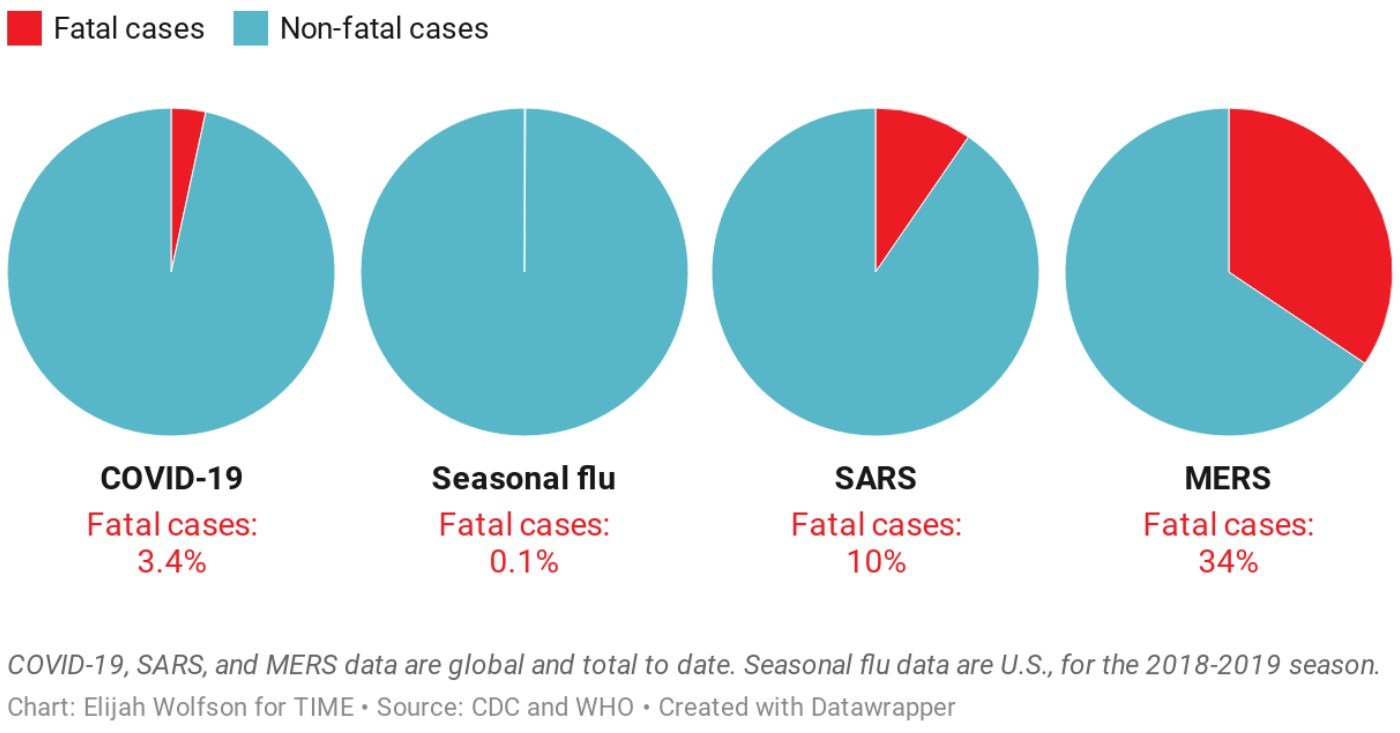
Since, as mentioned above, the symptoms of the coronavirus disease are common to those experienced during seasonal flu outbreaks, it makes it difficult to diagnose without specialized test kits that are in shortage in some countries.
Moreover, in the majority of infection cases, the course of illness has a mild form without any significant symptoms. It means that humans can become the COVID-19 carriers and transmit the virus from one to another if they don’t take prevention measures from spreading the infection. There is no available vaccine for the novel coronavirus yet, and there are some ongoing discussions among health experts and scientists about the efficiency of currently applied treatment. According to the published by Imperial College London on March 17, it might take at least 18 months to develop an appropriate vaccination for SARS-CoV-2.
As a response to the pandemic outbreak, the media started to spread information about the high transmissibility of the coronavirus infection and create panic among people worldwide. Also, as the disease evolves, countries close their borders, isolate citizens in quarantine, and put other limitations to prevent the wider spread of the disease. Such measures result in some drastic changes in peoples’ daily lives and behavior patterns.
Since it is impossible to make an exact forecast on how the situation will further develop, businesses have to adapt to new circumstances and think over appropriate strategies in line with the upcoming economy shift. Even when the pandemic comes to an end, its impact will likely have irreversible traces and lead to the establishment of a societal “new norm”. That’s why it is vital for retailers and manufacturers to understand the changing patterns of human behavior at various stages of pandemic evolvement.
How Pandemic Affects Purchase Decisions
After the novel coronavirus started spreading to other continents and countries beyond China, the pandemic panic arose everywhere. Currently, there are more than 180 countries with registered COVID-19 cases. The United States went up to the first lines by the number of affected people, which makes over 20% of the world’s total cases. News about the total number of sick people, mortality rate, and cities in lockdown create fear among people and affect their daily lives.
After the WHO declared that the SARS-CoV-2 outbreak is a on March 11, 2020, official recommendations about the measures to restrain the spread of the disease have been publicly announced. First and foremost, the importance of personal hygiene has been highlighted, which means frequent washing or disinfecting hands in the absence of soap and water. The health agency also called for practicing respiratory hygiene; in other words, closing one’s mouth and nose to have protection against droplets that might come from someone’s coughing or sneezing. In case a person notices any symptoms of getting sick, it is advised to stay home or seek medical help if the symptoms are similar to those of the coronavirus disease.
So, how does the global health crisis conditions change consumers’ purchase decisions? Of course, everyone’s first priority is their own health and wellbeing of their families. Undoubtedly, the early signals of potential pandemic threat resulted in people rushing for buying face masks and hand sanitizers on the basis of alcohol, as the latest was claimed as the necessary component for the effectiveness of such disinfectants. As the danger of the coronavirus emerged, people also tend to buy cleaning products for disinfecting surfaces at home, gloves, and other household supplies.
There was some confusion about the efficiency of standard surgical masks as a protective measure against the coronavirus infection versus high-grade N95 face masks. “N95” are the masks of an industrial standard that are usually used by workers to protect themselves from breathing in small particles, such as dust, mold, or aerosol paint. Since the respirators filter out 95% of airborne infection agents and bacteria and cover the face better, they are believed to be more efficient against viruses as well. No need to guess, it quickly led to shortages in the stock of the medical masks in pharmacies and health facilities. As millions of people also rushed to buy N95 respirators, it created a scarcity of necessary protection equipment for field workers and caregivers.
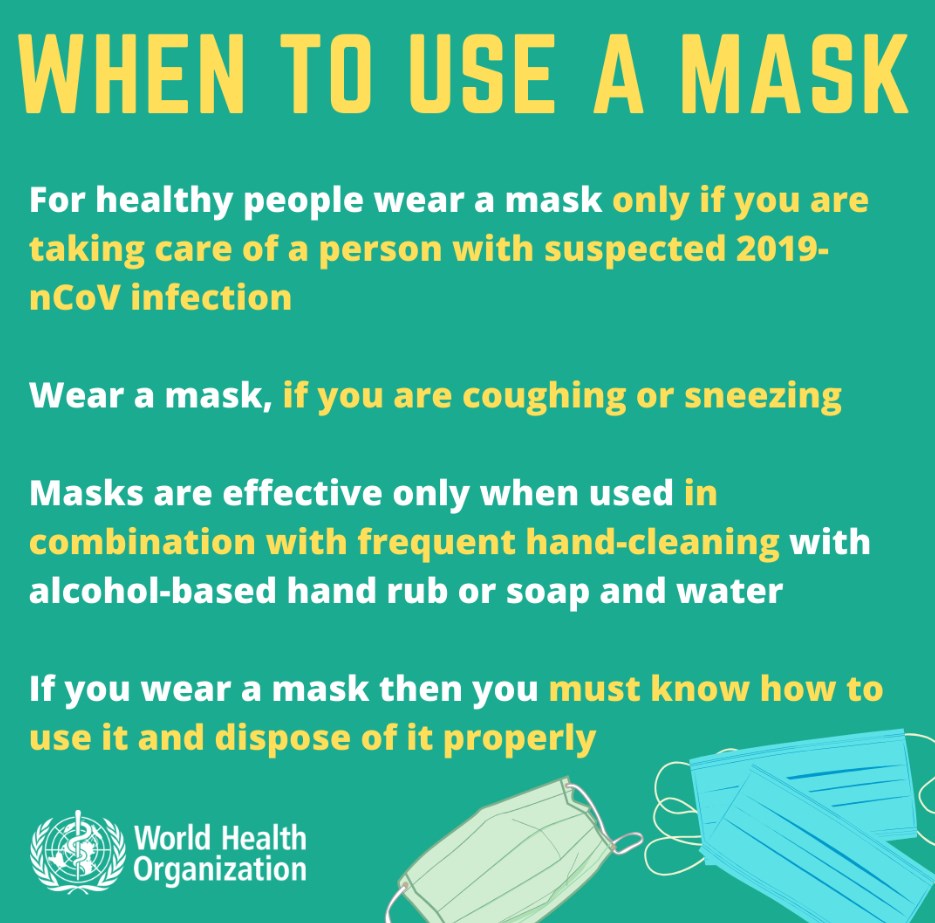
As for other health-supporting arrangements under the current COVID-19 outbreak, people tend to stock up medicines and supplements. Moreover, self-quarantine was declared as one of the necessary measures for preventing the disease spread in case a person feels sick or has been recently traveling. Due to this fact, an increase in the demand for anesthetic, immunomodulatory, antibacterial, and antipyretic drugs is inevitable. Besides the general cold, cough, flu, and other over-the-counter meds, people tend to buy more vitamins and food supplements with the view of boosting their immune system.
To a large extent, people’s choices are determined by present feelings and emotions. They are also influenced by media and behavior patterns in their environment. Since the city lockdowns already became a reality for many regions around the world and high probability for the countries where the pandemic is unfolding, there is a psychological trigger that makes people buy extra products. It is mostly related to basic necessity items, like toilet paper, personal care & health items, household supplies, and non-perishable foods. No surprise that bulk purchasing of products led to empty shelves in the supermarkets and shortages of stock.
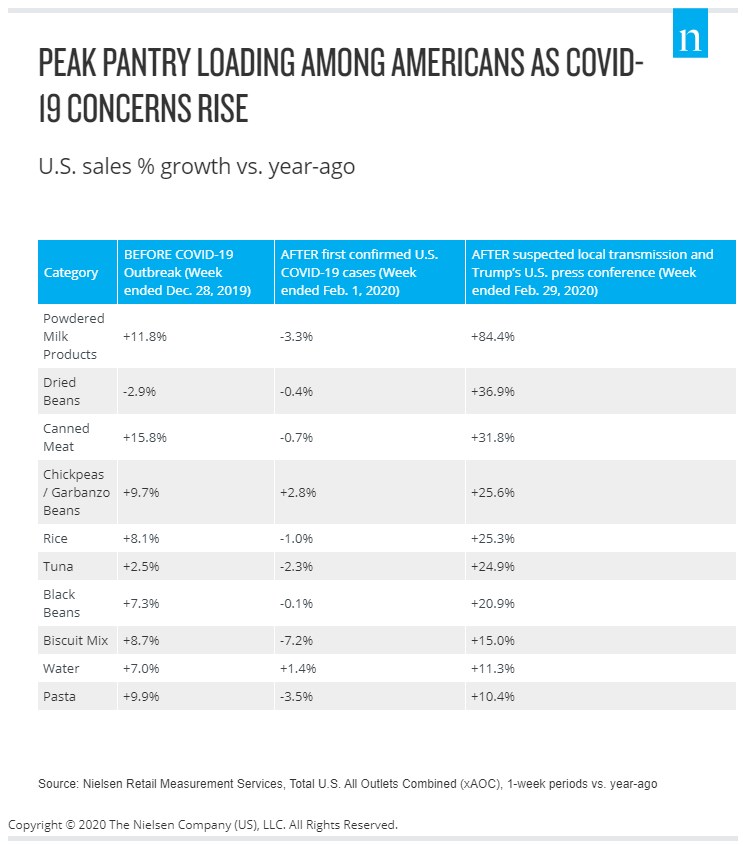
Nielsen defines six related to people’s shopping behavior during the COVID-19 outbreak. Basing on Nielsen’s research, the stage of stocking up packaged food and household supplies was on its peak during the threshold levels 1, 2, and 3, which are mostly related to the period of 8 weeks after the first case of coronavirus infection was registered in China. Behavior patterns tied to the mentioned thresholds occur in slightly different time intervals around the world, depending on the specific situation in a country. However, the shifts in customer shopping decisions are mostly common as the pandemic evolves.
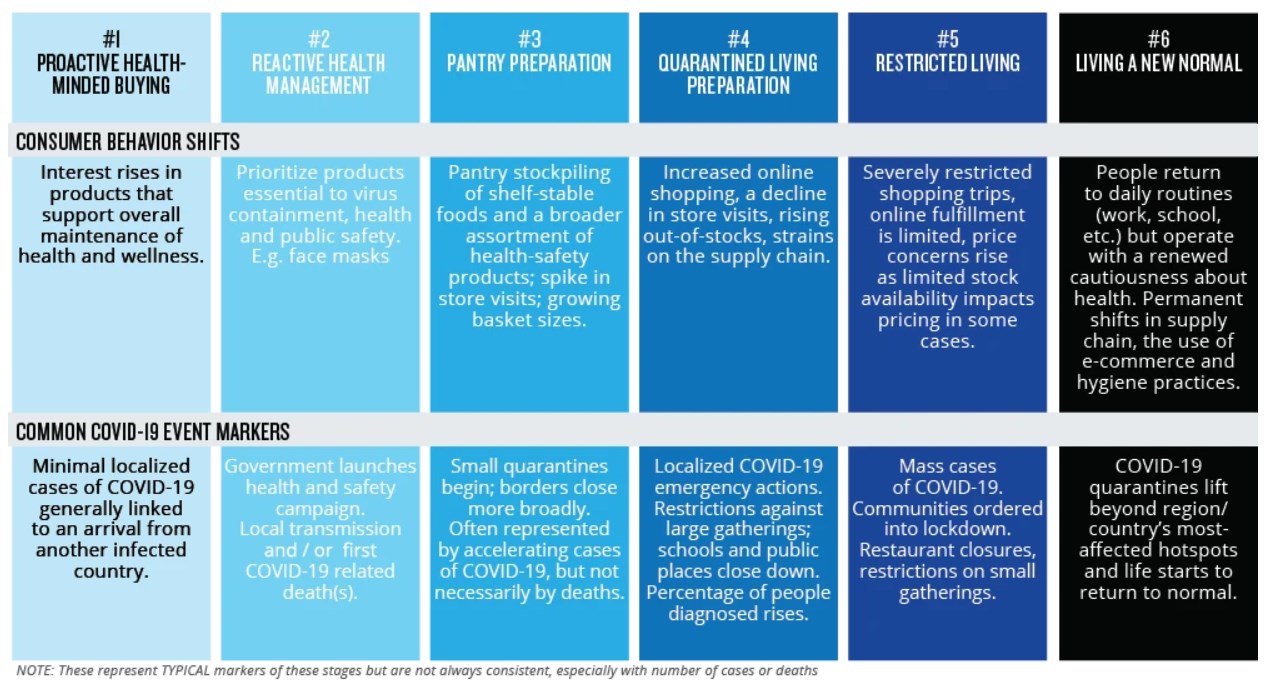
As the danger of the coronavirus spread increases, governments call on people to maintain social distancing and avoid communicating with others without urgent necessity. We already observe city lockdowns around the world, ban on gatherings, closure of schools, restaurants, and other public places, and restrictions on buying groceries in local stores. Such limitations lead to an increased fear of the coronavirus disease and make one’s safety and health a top priority.
One of the performed by Numerator provides insights into the people’s concerns about the current situation around the coronavirus outbreak for the last week of March. According to the responses of surveyed individuals, there was a shift of primary concerns to their own health and physical wellbeing of their friends and family, as well as impact on the economy and security at their workplaces.
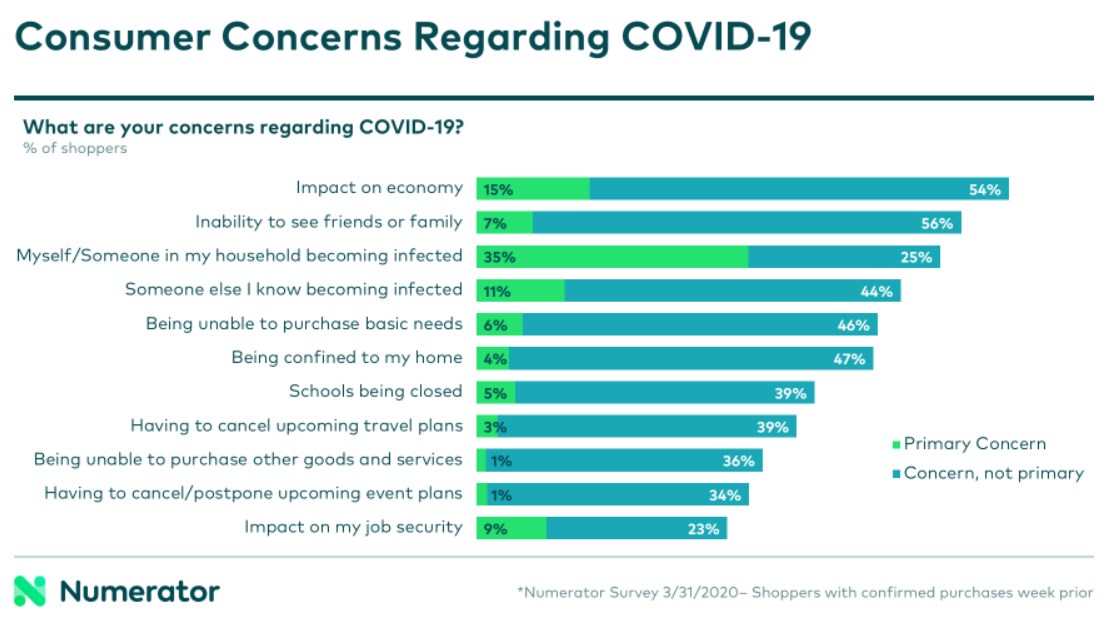
The Impact of Changes in Consumer Behavior on Retail Business
As the virus outbreak seems more life-threatening, people tend to avoid public areas, such as shopping malls and public transport. A report of Coresight Research published at the end of February showed that 27.5% of surveyed US citizens try to stay away from public places to a particular extent, while 58% of respondents were planning to decrease outdoor activities in the view of the corona pandemic unfolding.
Local grocery shops are less affected. However, a noticeable number of customers prefer to make their household shopping online instead of brick-and-mortar stores. According to the performed by Numerator, 28% of shoppers switched to making purchases online during the week of 12-17 March.
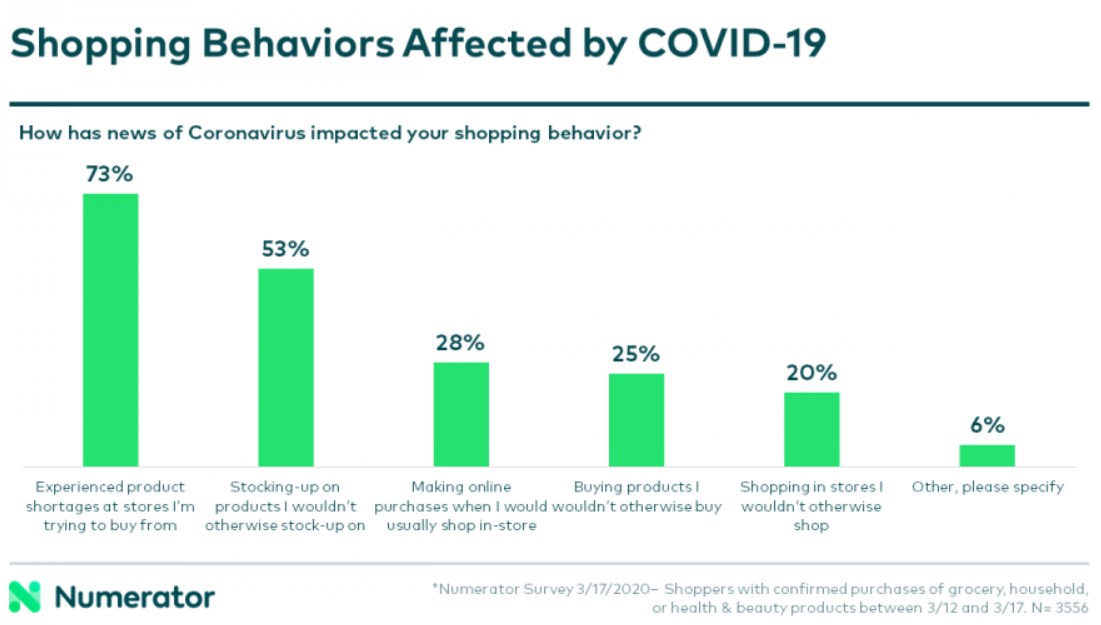
In the view of shopping panic around the emerging coronavirus outbreak and increasing shortages of supplies in brick and mortar stores, it is the time for the e-commerce business to step up to the front line. Since people get more concerned about the danger of leaving their homes, online shopping looks like a safer alternative. In addition, some countries apply limitations on the number of people allowed to stroll around the supermarket shelves at the same time, which leads to long queues and waiting hours and demotivates shoppers to go out even more.
If we look at the latest on the changes in consumer behavior compiled by Numerator, we can notice the increase of deliver-to-home and pickup-in-store options during March. For 13% of shoppers who chose home delivery option when making an online order, it was a ship-to-home experience for the first time ever or the first time within the last six months. As for the click-and-collect orders, 33% of customers were new to this option or used it first time for the past half a year.

However, fulfilling online orders might face difficulties due to the interruptions in the supply chain. While more countries get hit by the pandemic crisis, online shoppers experience delays in the delivery of their orders and an increase in prices, especially for products that are currently in high demand. That’s why it is crucial for merchants to monitor changes in customer behavior patterns and practice predictive analytics along with the updates on the virus outbreak. To track the changes in consumer behavior based on the latest monitoring data, follow the Numerator’s .
Since people in regions affected by coronavirus tend to reduce their in-store visits and make their daily purchases via the internet, pressure on online shopping infrastructure becomes higher. It leads to a situation when supply issues are inevitable for manufacturers and retailers of packaged food, household products, and sanitary & hygiene items.
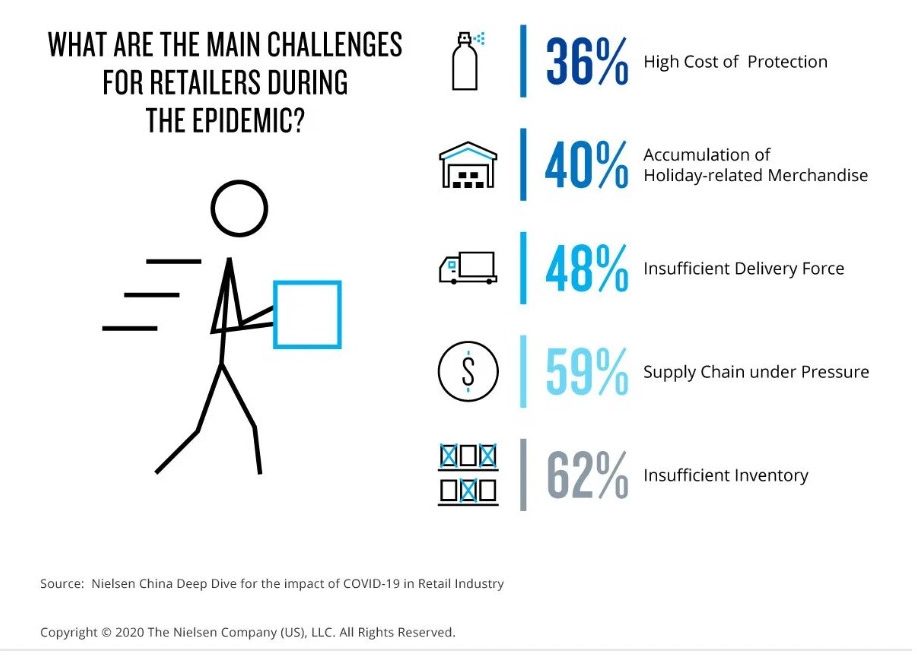
Besides, as the measures for containing virus spread are getting more strict, the probability of the global food shortage looks more real. In addition to increased demand from consumers, agriculture and food production industries might experience a lack of field workers due to the protective measures against the virus spread and stay-at-home orders. Also, import and export operations might be restricted, which will lead to interruptions in food supplies and an overall decrease in the volume of international trade. If the labor force is dismissed from work, and the normal logistics process is disrupted, the global health crisis will result in a food crisis.
Nevertheless, the potential difficulties in doing business in the view of the latest global and economic risks shouldn’t become a reason to give up. If you look at the situation from another angle, you can see new possibilities for sustaining your business and taking it to the new level after the crisis ends.
How to Turn the Pandemic Crisis into an Opportunity
The survival of retail business during the pandemic times mostly relies on the well-thought strategies based on forecasted tendencies. Business growth in post-pandemic times can become real if companies look into more efficient resource allocation, stable supply chain, and integrations across various channels. Undoubtedly, everyone will have to pass through the hard times, but if the retail industry tries to be agile now, it might lead to its growth after the crisis times.
Adverting to the corona outbreak thresholds defined by Nielsen and mentioned above, China is the only country that reached level 6 for now. In this way, China can act as an example of how things will evolve in the countries mostly affected by the epidemic. As the lockdowns of cities in China’s affected areas are being lifted, people start turning back to their normal lives, i.e., going back to schools, jobs, and doing other daily routines. The impact of the pandemic creates a so-called societal “new norm” that determines a new way of living and shift of priorities. It brings new challenges for the retail industry and commercial companies that have to adjust their marketing and sales strategies if they want to thrive in the emerging economic order.
According to another performed by Nielsen, 46% of Chinese retailers consider the crisis as an opportunity for developing their business in the following half-year period. However, 36% of respondents expressed their concern about rising pressure on the market in the post-pandemic economy.
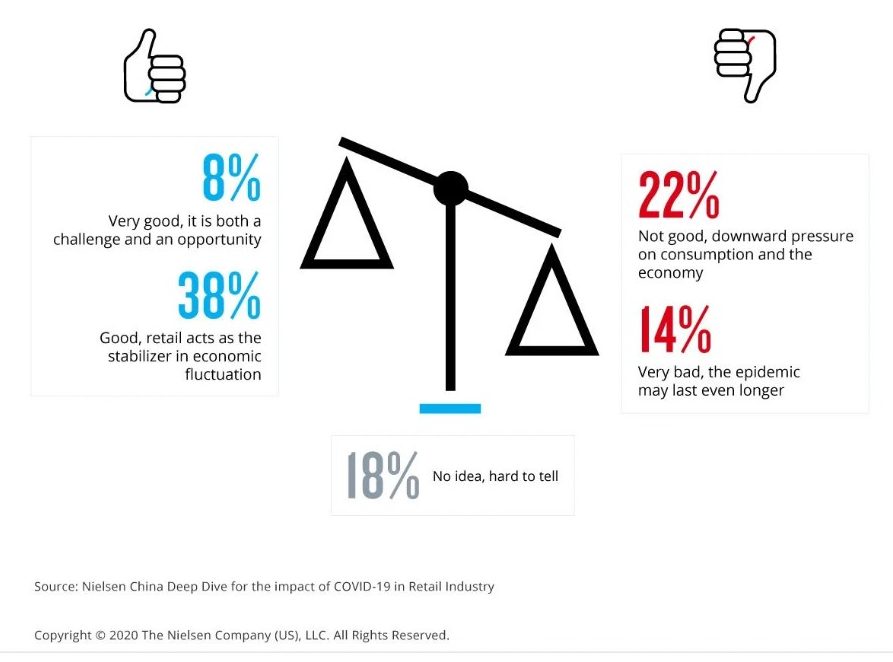
In the view of the lessons learned during the COVID-19 outbreak and expected changes in the societal “new norm”, we want to highlight the following measures that should be considered by businesses for surviving the pandemic pressure:
- Monitoring changes in the customer preferences
It is imperative for FMCG sellers to pay extra attention to the changes in customers’ demand in their local communities. Since the risk of catching the virus jeopardizes people’s health, customers become more health-conscious, which affects their shopping preferences. The latest dynamics in the retail sector showed the increased demand in health and safety-related items and wellness products, and this tendency will likely remain after the end of the pandemic. Companies that sell fresh food categories might also experience an increase in the demand for their products. New health and safety labeling also becomes crucial in winning concerned consumers.
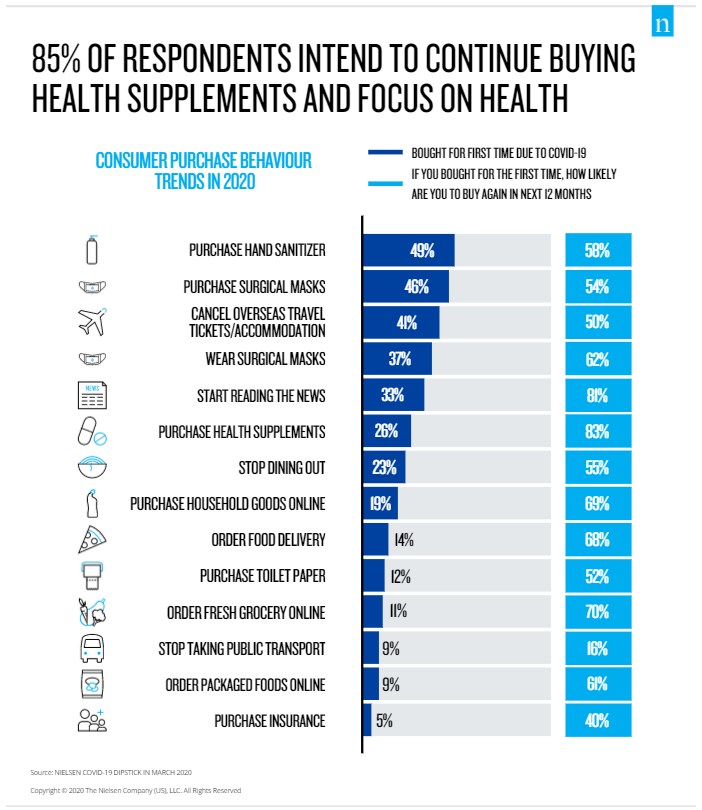
- Investing in the development of new e-commerce platforms
Following city lockdowns, quarantines at home, and social distancing orders, people have to look for new ways to fulfill their daily shopping needs. In this view, turning to online sales channels as a safer shopping option is inevitable. Besides, there is a probability of a new wave of infections once quarantines are over, and people start mixing again. Since individuals tend to remain more cautious about their health and social life after the coronavirus outbreak, the online retail business will see growth and more interest from potential clients. Older generations also start using more online sites to do their daily shopping in the view of mitigating potential health risks.
- Maintenance of existing online sales channels
For the retailers who already operate in e-commerce, it is important to make their online platforms ready for handling the increased number of customers and satisfying their demands. It is time for FMCG retail businesses to prioritize the optimization of digital operations. Since there is a dramatic rise in using online channels, companies should strive to provide a seamless and user-friendly experience for their e-commerce site visitors on both desktop and mobile devices.
- Prioritization of click-and-collect and home delivery options
Since home delivery for purchases made online and pickup-at-store options are becoming preferred among other shipping methods, retailers should concentrate their efforts on creating appropriate infrastructure. For improving the convenience of shopping and retaining customers, small and medium-size retailers might consider offering courier services to their clients.
- Reinforcement of supply chain
Since the pressure on product supply increases as the pandemic evolves, seeking reliable sources to ensure the availability of items, especially those that are currently in high demand, is crucial for retailers and manufacturers. By strengthening supply chains, both online and brick-and-mortar businesses will avoid loss of potential customers due to delays in restocking and delivery. In this matter, turning to new e-commerce channels that can help to stabilize product supply looks like a sensible measure. Besides, organizing particular warehouse layout changes might become necessary for some retailers.
- Focus on product quality
In a longer perspective, the importance of price as the main factor in purchase decisions diminishes compared to the product quality. As mentioned above, customers start paying more attention to the safety standards and origins of the items they buy. Such a tendency requires FMCG brands and manufacturers to clearly communicate their abilities to deliver high-quality products from reliable sources.
- Ensuring consumers of transparent supply chain
The importance for transparency of the supply chain is linked to the consumers’ concern about the quality and safety of goods they are buying, particularly food, cleaning items, and products for health support. In this regard, sellers need to rely on local products supply, as customers will not trust items imported from countries that are not safe due to the virus spreading. It implies some challenges for multinational brands that will need to adjust their tactics to ensure clients of their credibility.
- Omnichannel integrations
Developing an omnichannel strategy can become a smart solution for retail business owners who aim to provide customers with a comprehensive shopping experience across various sales channels. This strategy covers sales and marketing operations that integrate all customer interactions with both offline and online sales channels.
- Online and social media marketing
Since the usage of online sales channels will be growing across various customer groups, marketing and advertising plans should be re-considered. To catch online shoppers’ attention and raise their interest, retail brands should consider concentrating their efforts on a broader coverage of social media channels and focus on digital transformation.
- Focus on innovation and technology
For building a robust e-commerce strategy in the long run, it is crucial for retail companies to leverage available technology-enabled solutions. It concerns augmented and virtual reality tools that can be used for assisting customers in their daily shopping, as well as testing products without touching them.
- Appropriate branding
In times of uncertainty like a current virus outbreak, brands need to be able to add value to an individual’s “new normal” lifestyle. By creating positive impressions and promoting a healthy attitude to changing circumstances, companies can build confidence and gain customers’ trust. If brands deliver proper messages and show clients that their health and safety is the top priority, they can win back customers’ loyalty.
Final Words
It is undoubtful that, currently, humanity is experiencing unprecedented times that have an impact on all aspects of life. However, it is not the first pandemic surged around the world and probably not the last one. To survive hard times, everyone needs to stay away from the panic and focus on their own health and inner balance and the safety of their friends and family.
As for businesses, by continually monitoring shifts in customer behavior patterns and understanding how people react in a dynamically changing environment, they can find the basis for building their post-pandemic strategies. China and Italy can already act as examples of how things evolve in the situation of a global health crisis and help to track its implications on customer preferences.









